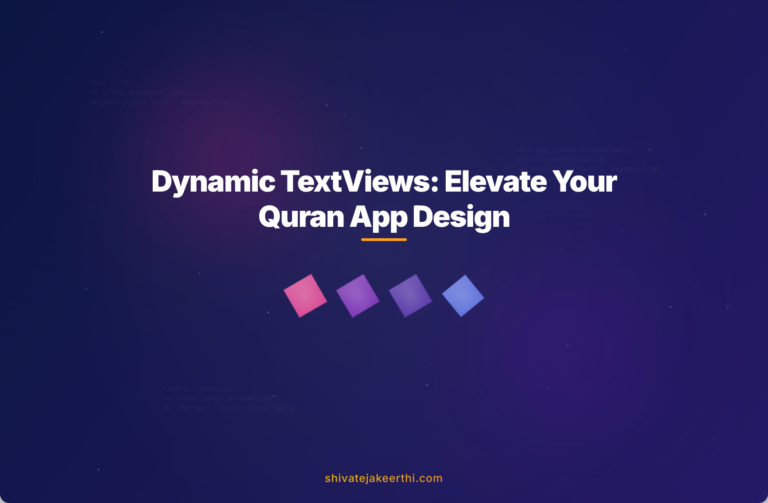Crafting an engaging and readable Quran reading app on Android can sometimes feel tricky, especially when handling text formatting. Suppose your current app uses static layouts or rigid TextView setups. In that case, you’re likely dealing with messy code and inconsistent layouts that don’t adapt well to different screen sizes.
If your goal is creating a beautiful, intuitive, and scalable UI matching a book-like Quran reading experience, dynamically adding TextViews for each verse—including clean line breaks—is your solution.
Why Dynamic TextViews Make a Huge Difference for Quran Verse Display
Quran verses vary significantly in length, from a few words to multiple lines. A static layout doesn’t handle this variation well, often resulting in poor readability or abrupt breaks.
When you dynamically add TextViews, each verse can easily fit the available space, adjust to different device screens, and create a smoother, more readable format. A dynamic approach lets you style individual verses, making it easier for users to follow along, especially for longer chapters.
Dynamic TextViews also allow for better future enhancements. For instance, if you later decide to add audio playback for recitation or verse bookmarks, dynamically generated views can integrate seamlessly with these features.
Technical Details: Understanding the Current Code and Its Limitations
Let’s imagine your current Android implementation uses predefined layouts, where each verse is manually placed in XML or repetitively coded in Java. The issue here is obvious: repetitive manual adjustments and poor adaptability to verse length variations, screen orientations, and different device types.
Consider this simplified example of your current hardcoded approach:
<LinearLayout
android:id="@+id/verse_layout"
android:layout_width="match_parent"
android:layout_height="wrap_content"
android:orientation="vertical">
<TextView
android:text="Verse 1 content here..."
android:layout_width="match_parent"
android:layout_height="wrap_content"
/>
<TextView
android:text="Verse 2 content here..."
android:layout_width="match_parent"
android:layout_height="wrap_content"
/>
</LinearLayout>
This method quickly becomes impractical. It’s prone to human errors, lacks scalability, and proves challenging to maintain, especially with large Quran chapters.
Implementing Dynamic TextView Addition with Line Breaks: Step-by-Step
Thankfully, Android’s powerful APIs mean there’s a better way, using Java programmatic UI manipulation. Here’s a clear breakdown:
1. Define Your Parent Layout
First, add an empty vertical LinearLayout or ScrollView in your XML file as a container:
<ScrollView xmlns:android="http://schemas.android.com/apk/res/android"
android:id="@+id/scrollView"
android:layout_width="match_parent"
android:layout_height="match_parent">
<LinearLayout
android:id="@+id/verseContainer"
android:layout_width="match_parent"
android:layout_height="wrap_content"
android:orientation="vertical"
android:padding="16dp">
</LinearLayout>
</ScrollView>
2. Dynamically Create TextViews in Java
In your Java activity file, iterate through your Quran verses, dynamically creating and adding TextViews to the parent layout:
LinearLayout verseContainer = findViewById(R.id.verseContainer);
String[] verses = getResources().getStringArray(R.array.quran_verses);
for (int i = 0; i < verses.length; i++) {
TextView verseView = new TextView(this);
verseView.setText(verses[i]);
verseView.setTextSize(18);
verseView.setTypeface(Typeface.SERIF);
verseView.setPadding(0, 8, 0, 8);
verseView.setLineSpacing(1.2f, 1.2f);
verseView.setTextColor(Color.parseColor("#333333"));
// Verse numbering styling
verseView.append("\n(" + (i + 1) + ")");
verseContainer.addView(verseView);
}
Here, we use a verse array (from resources) to dynamically populate TextViews, achieving neat and readable line breaks automatically.
3. Handle Responsive Layout and Styling
To further enhance readability, customize your TextView’s attributes to match user preferences like font sizes, line spacing, and alignment. You might even justify text alignment for a professional book-like feel.
Consider using JavaScript and WebView integration if you want richer styling like justified text and custom fonts with easier CSS support.
Code Refactoring and Performance Optimization
Creating dynamic views can add overhead if done improperly. Let’s make your approach scalable and performant:
- View Holder Pattern: Reuse and recycle views efficiently within RecyclerViews if loading large Quran chapters.
- Lazy Loading: Dynamically load views as users scroll, dramatically improving your app’s responsiveness.
- Code Readability: Encapsulate your verse-generation logic into reusable methods or custom classes. It simplifies future modifications.
- Interactive Features: Allow long-press or tap actions to show meanings, translations, or markers.
Testing and Debugging for a Flawless Quran Reading Experience
Adopt a rigorous testing practice on different emulators and real devices with varied screen sizes (phones, tablets). Ensure line breaks, verse numbers, and text alignment consistently render beautifully. Catch issues early by frequently testing and debugging layouts using Android’s layout inspector tools.
Handling special cases—such as long verses, Arabic special characters, or smaller phone screens—is crucial. Testing extensively ensures predictable and visually appealing results for all users.
Integrate Quranic Features to Enrich Your User Experience
Dynamically added TextViews lay the groundwork for powerful Quran-specific interaction features:
- Bookmark Verses: Let users save favorite verses with easy access by dynamically binding interaction listeners.
- Select and Share: Allow selecting text for easy sharing or copying—a common user expectation nowadays.
- Audio Integration: Add audio playback per verse (using MediaPlayer API) for guided recitations.
- Future Scalability: Efficiently designed dynamic layouts naturally support advanced features like verse interpretations, context-based searching, and more interactive enhancements later.
Delivering a Rich and Engaging Quran Reading App
When you dynamically add TextViews with clean line breaks, you open a world of intuitive, readable book-like Quran verse screens. This solution ensures excellent flexibility, responsiveness, and user-friendliness for your Android Quran app.
It boosts user engagement, satisfaction, and app reviews, laying the groundwork for future updates and easy integration of additional Quran-related features. Users get a consistent reading experience that closely mirrors a printed Quran, significantly enhancing usability, retention, and satisfaction.
Have you implemented similar UI solutions in your Quran or text-specific apps? Share your experiences or questions in the comments below!



0 Comments